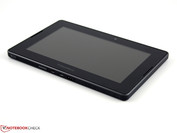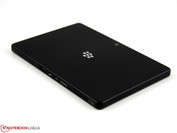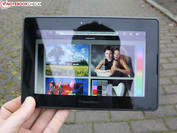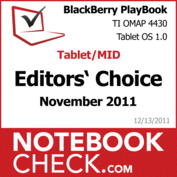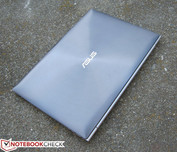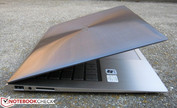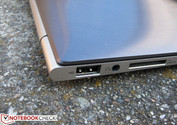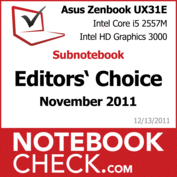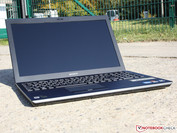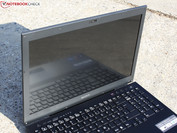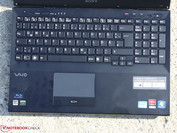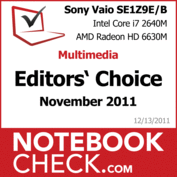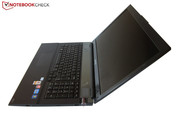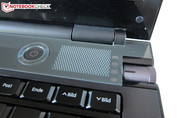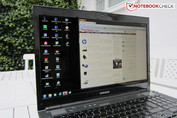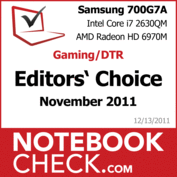Notebookcheck's Best of November 2011
Selected devices from the categories tablet, subnotebook, multimedia and gaming/DTR kept us busy in November. Class rather than mass was our motto and thus we neglected office-books (Lenovo ThinkPad T420s), netbooks (Asus Eee PC R051PX) and workstations (Dell Precision M6600). Tablets from Toshiba, Sony and RIM passed through our hands, whereby we liked the folding concept of the foldable Sony Tablet P in practical use a lot. However, another one took the prize.
The subnotebooks were dominated by two Asus ultrabooks which couldn't convince in mobility. The multimedia devices partly had surprisingly good screens. A device aligned for business was the winner here. Finally, the frame machines from the gaming sector aimed for new top rates in performance, and SSD+HDD arrays called the shots. Find out in this article, which devices are the November winners in every category.
Category: Tablet/MID
The contenders:
Toshiba AT100-100 84 %
Sony Tablet P / S2 87 %
BlackBerry PlayBook WiFi 16GB 88 %
The Toshiba AT100-100 made the start into the small tablet round in mid November. It is known as Thrive in the USA. As expected, the standard system with Nvidia's Tegra 250 and Android 3.1 doesn't show any shortcomings, except one: Android fans would have appreciated the newer Android 3.2 Honeycomb. The case is rather basic in comparison to others because it's made of rubberized plastic and lacks any aluminum applications. The screen's low brightness and the intensely reflective TFT are the biggest drawbacks. In return, the price of €360 for the wifi version is attractive.
With the Sony Tablet P (formerly S2), the manufacturer has accomplished the rare feat of making a foldable mini tablet with two IPS screens. We liked the handling and the operating concept a lot because a 7 inch screen (2x5.5 inches) can't usually simply be stowed away in a jeans pocket. Viewing angles and screen brightness are very good, just like the six hours of battery runtime. The drawbacks are seen in the insufficiently mounted upper shell and its scratch-sensitivity. This shouldn't be the case in a €600 device (3G version).
The Blackberry Playbook WiFi 16 GB from RIM uses the fast OMAP chipset from Texas Instruments and the company's own Blackberry Tablet OS 1.0. The basic, yet very stable device convinces with an intuitive navigation concept (swiping over the sides) and thus manages without buttons or built-in Home, Back and Menu buttons. Although it has been named PlayBook, RIM is aiming at professional users with the security and synchronization options besides a well filled App World (regarding Productivity). Outdoor use of the PlayBook is perfect. We are looking at the brightest tablet screen that we have ever assessed. Moreover, it has a battery life of seven hours and displays rich, bright colors. The smallest wifi version, without 3G, is available for €329.
Tablet/MID of November 2011: BlackBerry PlayBook WiFi 16 GB
The Blackberry skids past the Sony P with a marginally better rating. Both devices have their big advantages. The Tablet P's are its handy size and the good battery life. The PlayBook is at the front with its fast usability and the very bright screen. The poor workmanship, which opposes the BlackBerry's stability, is decisive for the Sony Tablet's disadvantage. A drop of bitterness of the PlayBook: The 3G version is not yet available on the German market. Until now, the user needs a BlackBerry smartphone to tether the tablet to the Internet.
What we like
The control concept with swiping over the lateral edges. The super bright screen is a knockout.
What we'd like to see
A timeout of more than five minutes.
What surprises us
The App World has a lot of tools, applications and games. Tablet OS doesn't cut back on security functions, such as certificates, authorizations and security wipe.
The competition
On the Android system side, we see the Sony Tablet P / Tablet S as such due to its handy size. The Dell Streak 7" is also handy, but doesn't have a viewing angle stable screen. The HTC Flyer 7" WiFi +3G proliferates with Access Point function and Magic Stick for perfect stylus inputs. Lastly, everyone is waiting for the Samsung Galaxy Tab 7" successor, the Galaxy Tab 7 Plus with Android 3.2.
Category: Subnotebook
The contenders:
Asus Zenbook UX21E Ultrabook 86 %
Asus Zenbook UX31 Ultrabook 87 %
Samsung Series 3 300V3A-S02DE 81 %
The ultrabooks are coming! The 11.6 inch Asus Zenbook UX21E made the start. Comparisons with the smallest MacBook Air were of course logical in this case. The application performance with the fast ADATA SSD is excellent for an ultra slim mini subnotebook. Especially since Asus doesn't fear using the comparatively strong ULV processor, the Core i7 2677M (2x 1.8 GHz). The UX21E's biggest feature is the aluminum case on a par with Apple's unibody design in terms of quality. The lid and chassis are extremely rigid. The screen shows another extreme: On the one hand, it has a very low contrast and frustrates mobility fans with its glare type. In return, the screen lights up with a brightness of 144 cd/m2, a new top rate. The rather short runtime of less than four hours are due to the 35 watt lithium polymer battery. It's not been given a bigger capacity for space reasons. The price of €1099 is acceptable for the extravagant, seemingly milled of one piece mini device – although the glare type spoils the main field of use: Mobility.
Right on its heels, the big brother, Asus Zenbook UX31 achieved one point more (87%). The looks, the case and the interfaces are the same as in the UX21 – so just as poor. But at least one of the two USB ports is a USB 3.0. The extremely fast 128 GB SSD ensures strong application performance (Intel Core i5 2557M). It is well in line with a considerably better battery runtime of five to seven hours. Together with the very bright and, again, both reflective and pale TFT, this device can be used on the go. The resolution of 1600x900 pixels is good for serious work. The price of €999 for one of the first ultrabooks is acceptable.
The Fujitsu LifeBook SH531 looks virtually gigantic compared with both ultrabooks. But then, the 13.3 inch model, based on a standard Core i5, only costs €500. We couldn't find any real advantages in the high-gloss device. The battery life is short (four hours), the screen is reflective, has a low contrast and the gaming performance is extremely low. We see the low emissions in temperature and system noise as a pro.
Samsung's 3003A-S02DE goes in the direction of the LifeBook SH531 because it is also a fairly bulky subnotebook. However, Samsung has improved the crucial points and offers a matt screen with a feasible brightness. The input devices, so the keyboard and the touchpad, supply good feedback. The good performance with a Core i5 and a dedicated GeForce GT 520M is impressive. The latter even allows playing a few up to date games in low details. The battery life of 6:20 hours (WLAN test) and the short charge time of two hours encourage mobile use. Unfortunately, the case partly allows warping. The system noise during load and the waste heat of the 13.3 inch model don't break any records. Only the Silent Mode does its name justice.
Subnotebook of November 2011: Asus Zenbook UX31
The Zenbook UX31 rightfully claims the award just looking at its score. Despite the low build, the fan is almost never audible even during load. That is just as remarkable as the low temperatures of selectively 43 degrees Celsius at most during load. The keyboard with the firm pressure point and the touchpad with the "built-in" keys are pleasant to work with (after the driver update). Those who don't like the 13.3 inch MacBook Air, but want an extremely thin and high quality computer anyway, should take a closer look at the UX31.
What we like
The super-fast SSD brings us one of the most responsive notebooks yet, despite ULV-CPU.
What we'd like to see
A backlit keyboard and matt screen option would have made the notebook even more appealing.
What surprises us
The first generation Zenbook series has made a big splash in the still young ultrabook market. If Asus can keep this up and lower their prices, then we may have a serious MacBook Air competitor in no time.
The competition
Immediate competitors include the Acer Aspire S3 and 13.3 inch MacBook Air. General competitors include the Lenovo X1, Dell Inspiron 14z and Samsung Series 9. More Ultrabooks, such as the Lenovo U300s, are expected to launch within the coming months.
Category: Multimedia
The contenders:
Samsung Series 7 Chronos 700Z5A 83 %
Asus N55SF-S1124V 82 %
Acer Aspire Ethos 5951G-2631675Wnkk 80 %
The Series 7 Chronos is Samsung's premium multimedia machine and it displays its strengths in many areas. The configuration with a Core i5 and AMD Radeon HD 6750M (can be disabled) provides good performance rates. Since customers want both memory capacity and speed, a 750 GB HDD and an 8 GB ExpressCache are installed. They store frequently required files and thus the load times are accelerated. The slim build and the elegant aluminum looks are in line with the good battery life of six hours, as well as the matt screen. The latter delights with a HD+ resolution, but disappoints with low contrasts and poor viewing angles. Another drawback is the regrettably not perfectly rigid case. The Chronos with a Core i5 is available for starting at €940.
Sony's Vaio VPC-SE1Z9E/B presents itself as a professional consumer and business device in an overall favorable light. The rating of 83% isn't quite perfect, but it has details of the premium business standard. This would first be the contrast and viewing angle stable Full HD screen with a matt surface (VAIO Plus Display). The interfaces, including docking port and battery slice connector, are generous. The integrated 3D module could have made mobility perfect, but the battery life of nearly three hours unfortunately ruins it. The keyboard doesn't achieve the perfect feedback of business input devices as found in a HP EliteBook or Lenovo ThinkPad. The Radeon HD 6630M graphics is even suitable for an odd game, though not in the native resolution.
A new version of Asus' premium multimedia device is available in the N55SF-S114V. The 15.6 inch laptop can reap in a good rating for its rubberized and rigid case with a sensitive lid. The temperature and system noise aren't stressed by the quad core i7 and NVIDIA GeForce GT 555M in high load. Extra points are due for the low reflection, very bright screen with feasible contrasts. We liked the lateral viewing angles just as much as the sound quality rendered over the included external subwoofer. The keyboard has a layout that needs getting used to.
Acer's flagship gamer, Aspire Ethos 5951G achieves a rating of 80% in this round. This isn't actually bad because it shows that Acer has done a lot of things right. That would be the strong battery life of 5:33 hours (WLAN test), the good sound, the many interfaces and the removable touchpad. The latter can be used as a remote control. However, the device's big shortcoming becomes evident especially when several people gather around the standard resolution of 1366x768 pixels to consume media: The TFT's poor contrast, narrow viewing angles, low brightness and a color spectrum considerably smaller than sRGB doesn't fit to a premium model for just under €1200. The Blu-Ray drive doesn't seem in line with the low resolution. The screen in the Asus N55SF would have been just right for the Ethos 5951G.
Multimedia notebook of November 2011: Sony Vaio VPC-SE1Z9E/B
Since we had a tie, we decided in favor of the Vaio due to the better screen. The VAIO Plus Display is exactly the screen that the Samsung Chronos would have desperately needed. On the other hand, the Vaio could have also used the good input devices of the Chronos just as much as the low waste heat during load. The Vaio reaches a temperature of up to 56 degrees here and the CPU throttles in short intervals.
What we like
A great screen for working inside and out. All professional options are available: A battery slice and docking station can be bought additionally.
What we'd like to see
The short battery life of this 3G model isn't acceptable for mobile workers. Feedback strong keys would have been perfect.
What surprises us
One deficiency is eliminated (TFT), another is created (battery life).
The competition
Semi pro: Samsung RF511-S05DE: quad core, GT 540M, matt but poor TFT; Fujitsu Lifebook NH751: quad core, very good TFT; Gigabyte P2532N: strong GT 555M graphics, very good TFT; Samsung Series 7 700Z5A: Radeon HD 6750M, matt but poor TFT
Pro: Dell Latitude E6520 i7/FHD: matt TFT, good colors; HP Elitebook 8560p-LQ589AW: good WXG++ screen; HP ProBook 6560b-LG658EA: weak WXGA++ screen; Lenovo ThinkPad L520 NWB53GE: perfect inputs
Category: Gaming/DTR
The contenders:
Samsung Series 7 Gamer 700G7A 85 %
Schenker XMG P511 84 %
Medion Erazer X7813 82 %
The first full-fledged (17.3 inch) gaming notebook from Samsung almost does a perfect job with everything in its attack on the gaming sector – and some things are even perfect. The screen with 1920x1080 pixels bids a very high contrast (953:1) and even covers the sRGB color space a bit. The glare type screen's brightness is so good that sun worshippers can even surf with it outdoors. The (2GB GDDR5!) AMD Radeon HD 6970M's gaming performance allows playing in Full HD, at least in most of the up to date games. The 7200 rpm HDD and the quad core i7 2630QM prove to be strong, but not perfect. The system noise is over the low levels known from Samsung. The 700G7A is only inaudible in Silent Mode.
MSI relies on the strongest Nvidia single core graphics card in its Gamer, MSI GT780DX. The GeForce GTX 570M is equipped with GDDR5 and can render up to date games smoothly even in the native Full HD resolution. The performance is rounded off with the Core i7 2670QM and an Intel SSD (rating 95%). Unusual for the gaming sector is the non-glare Full HD screen with an outstanding contrast of 869:1 and wide viewing angles. However, the device isn't quiet when it comes to system noise. The cooling howls along during load, and in particular with the Turbo Cooler (button). €1800 for such a tremendous laptop seems appropriate for a high-end behemoth. However, the expert Schenker shows that more speed is possible for less money, so less expensive.
The Schenker XMG P511 is also equipped with a GeForce GTX 570M. The Intel Core i7 2760QM can extract a bit more performance. The price for this 15.6 inch XMG behemoth: €1686. However, the buyer not only gets a 128 MB Crucial Real SSD M4, but also a Samsung Spinpoint M8 with 1000 GB! We gave the performance of this extreme combination a rating of 95% (games) and 100% (applications). More isn't possible for a 15.6 inch device. However, the rating keels over due to the only satisfactory workmanship of the case and the input devices. An enormous noise development during gaming reduces the score even more.
The Erazer X7813 from Medion is a 17 inch notebook that copies the XMG P511's strategy. Medion combines the strong quad core i7 2670QM with an NVIDIA GeForce GTX 560M, an SSD, a hard disk and with a contrast strong Full HD screen. The input devices and the workmanship also clearly lag behind the performance in this case. At the same time, we also criticize the extremely loud fan during load operations. The performance, even for games, is lower than in the XMG P511 for a price of €1200.
Gaming Notebook of November 2011: Samsung Series 7 Gamer 700G7A
The Samsung doesn't by far have the best performance (no real SSD), but the 17 inch laptop makes the best overall impression. While the other machines show shortcomings in workmanship, input devices and system noise, the 700G7A provides top rates or at least good readings. Samsung's gamer not only has a great screen, its handling is also enjoyable. The dial jog wheel with the four operating modes (Gaming, Balanced, Library & Green) fits perfectly to a gamer, respectively a desktop replacement. The price of €1650 is steep and only justified for those who definitely want to call a top screen and the currently fastest (single) Radeon graphics (HD 6979M) their own. In terms of application performance, the MSI GT780DX and Schenker XMG P511 have a better configuration (SSD performance boost).
What we like
Samsung has opted for an extremely fast high-end GPU with the Radeon HD 6970M.
What we'd like to see
A matt case lid and a better battery life.
What surprises us
Such a bright and contrast rich screen isn’t offered very often.
The competition
17 inch laptops with a gaming graphics card, such as the Alienware M17x, the Asus G74SX, the DevilTech Fragbook, the Medion Erazer X7813, the MSI GT780R, the Schenker XMG P701 PRO or the Toshiba Qosmio X770.


 Deutsch
Deutsch English
English Español
Español Français
Français Italiano
Italiano Nederlands
Nederlands Polski
Polski Português
Português Русский
Русский Türkçe
Türkçe Svenska
Svenska Chinese
Chinese Magyar
Magyar